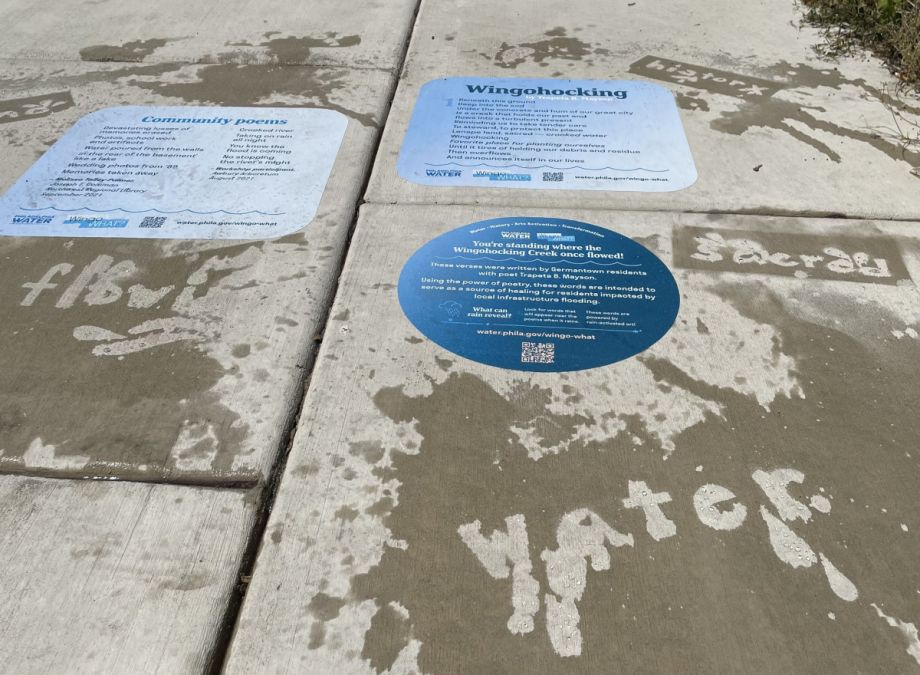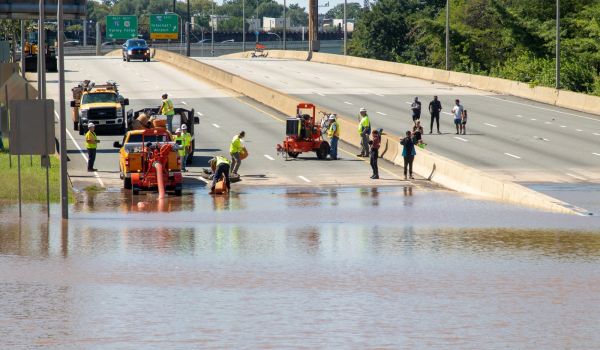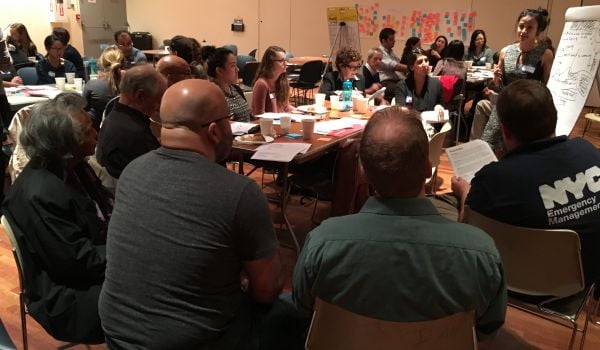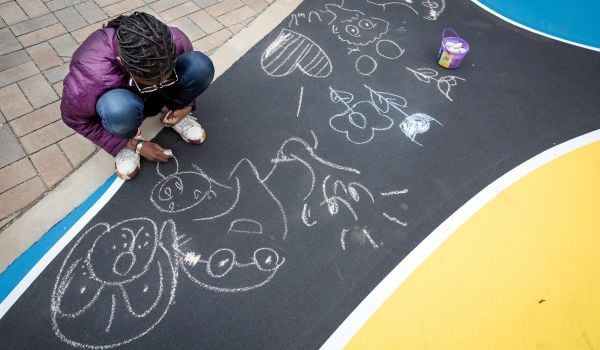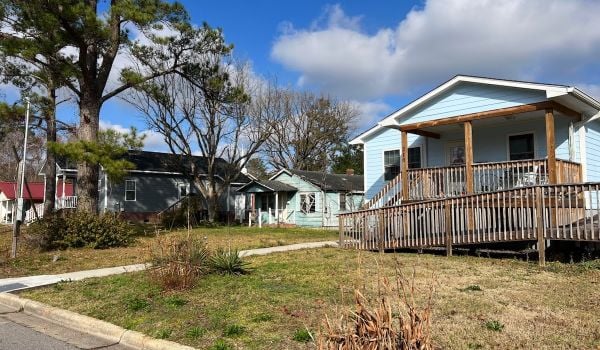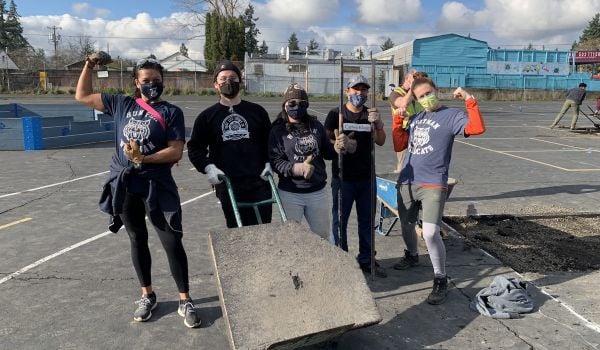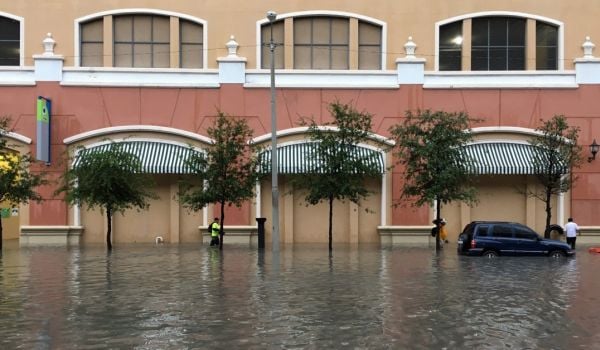As rain falls on certain blocks of the Germantown neighborhood of Philadelphia, the sidewalk reveals something surprising. As the pavement gets wet, it displays verses of poetry about the impacts of intensifying neighborhood flooding. Crooked water / Still or rising, one poem reads. Flooding or hushed / Indelible marker on our lives / Photos and memories and precious things / Taken and carried in your rushing flow…
These water-activated rain art and decals feature poems written by Germantown residents, who have been increasingly engaged by the Philadelphia Water Department to determine how the neighborhood will build flood resilience amid a deepening climate crisis.
“None of this is happening in a vacuum,” says Maura Jarvis, the assistant manager of the public engagement team for the Philadelphia Water Department. In addition to conducting community outreach for green stormwater infrastructure projects, she oversees the Germantown Community Flood Risk Management Task Force.
“About three years ago, we started a stakeholder task force in Germantown because we wanted to create a space for community leaders, business owners, and city agency representatives to talk about what residents are expecting from us, what mitigation strategies are appealing, and how we can disseminate information in an efficient way.”
The decision to create a community stakeholder network, and also explore creative engagement strategies, is partly because of Germantown’s complex environmental history. The neighborhood is home to historic waterways, which were transformed into sewers. During heavy rainstorms today, these underground sewers carrying stormwater become overwhelmed, forcing water above ground and flooding resident properties, backing up their toilets, storm drains and outside manholes.
This type of flooding, classified as “infrastructure flooding” or “urban flash flooding,” has emerged as a major challenge in many cities as climate change has increased the frequency and severity of rainstorms.
“This is the largest sewer shed in the city,” says Julie Slavet, executive director of the Tookany/Tacony-Frankford Watershed Partnership, Inc. and a member of the stakeholder task force. “That [history] has really impacted where we are where we are now.”
Back in 2019, city reps participated in the U.S. Water Alliance’s Equity in Climate Resilience & Urban Flooding Bootcamp and seeded the idea to develop a community task force to address urban flooding concerns in Germantown. They recruited about 12 community leaders, faith leaders, small business owners and other concerned residents o for what became the Germantown Community Flood Risk Management Task Force. “The idea was to lay a foundation so we could address flooding in a way that was informed by community leaders, and not just something like a technical study,” Jarvis explains.
During 2020, the task force held in-person and virtual meetings to discuss the city’s flood management programs. It was a chance for community members to meet other city representatives handling flood issues, agencies like License and Inspection and the Philadelphia Office of Emergency Management.
The task force felt that residents needed to better understand how different city and federal agencies responded to flooding, and where residents could find support. They distributed resources like flood insurance information, Philadelphia’s flooding guide, basement protection resources and copies of the Germantown Storm Flood Relief Study. They got familiar with shorter-term, neighborhood-based resiliency efforts as well as bigger infrastructure projects planned by the city. “There was a need to get informed about that range … we will have to alert our neighborhoods when huge infrastructure comes to their street,” says Ruth Seeley, a task force member who is also part of Friends of Vernon Park.
Task force members also learned about the history of flooding in Germantown and developed a two-page fact sheet titled Why Germantown Floods to share with neighbors. “There was a need to educate people about why flooding was happening, and exploring some creative ways to engage with people,” Slavet says. They found it was critical to tailor information to the local community — no section of Germantown is recognized as an official floodplain by FEMA, for example, which means residents are not required to have flood insurance.
In 2021, in lieu of holding a town hall or meeting, the Philadelphia Water Department received grant funding to work with an artist to engage Germantown residents creatively.
“This wasn’t about creating a space for the city to share information with residents, or say this is what we want,” Jarvis says. “It was about creating a space to say whatever you want, share your experiences, your feelings on how flooding has been handled or not, property loss, memories. It was a way to open the door to larger conversations that do need to be had.”
With help from task force members, the Philadelphia Water Department selected Germantown-based Trapeta B. Mayson, Philadelphia’s 2020–2021 poet laureate, to lead the initiative. Through the summer and fall, Mayson led six poetry workshops, one virtually and five in-person around different sites in Germantown. During each, Mayson provided poetry prompts that helped participants begin writing out their feelings about water. “I found people were really excited to talk about these things within an artist framework,” Mayson says.
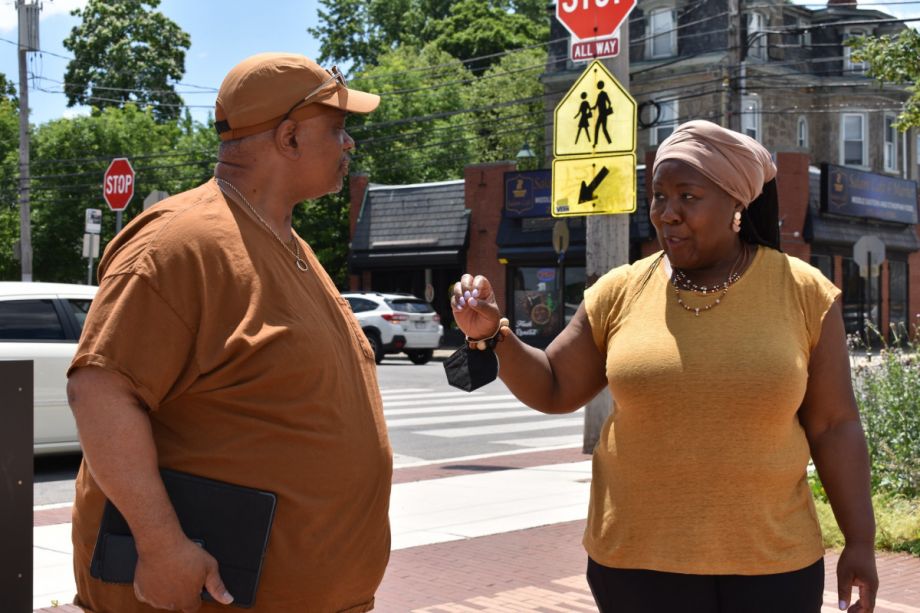
The city's former poet laureate Trapeta B. Mayson, selected to develop and lead the Wingo-WHAT?! creative intervention, speaks to a local at the program's June 4, 2022 event. (Photo courtesy Philadelphia Water Department)
The project was called Wingo-WHAT?, after the former Wingohocking Creek, which became part of the city’s sewer system. (WHAT is an acronym for water, history, arts activation and transformation.) “Forums and meetings by themselves often don’t cut it — one of the biggest things that came out in Germantown was that there was meeting fatigue,” Mayson continues. “I hope the task force and the city take away that you can use creative techniques and exercises to engage.”
This summer, Mayson and the water department hosted a cumulative event to bring participants together and reveal an on-the-street art installation series. Their chosen medium was rain art, a technique that’s been utilized in Boston for city-led projects.
Vinyl decals and rain art — which appear on the sidewalk when it rains — display information about the Wingohocking Creek, stanzas from a poem Mayson wrote that culminates participants’ poems, as well as community poetry. The Philadelphia Water Department placed the installations in spots prone to flooding and community hubs with high foot traffic.
Still, there’s concern in Germantown that the current engagement isn’t meeting the level of risk the neighborhood faces. “At the culminating event, someone I knew said this work was all well and good, but they were wondering how they would get their needs addressed,” says Mayson.
This kind of feedback has pushed the city not just to think about long-term infrastructure plans and increase its focus on more immediate resources and support. “The community is telling us they need shorter-term solutions, things that can be done right now,” Jarvis says. With help from the task force, she adds, “We now have a more open channel of communication.”
Deeper conversations and harder questions are to come. “This kind of work takes a lot of time,” Slavet points out. “People first need to understand what’s happening and then you can talk about the solutions.”
Some properties in Germantown will face such regular flooding that the community will need to discuss property buy-backs and returning some of the neighborhood back to nature, she adds. “There’s a question of why we should rebuild these homes … one thing the task force really needs to do is engage on a property-by-property basis.”
Jarvis hopes this early work of community building, creative engagement and building trust will lead to impactful long-term resiliency. The poetry project hasn’t solved anything, she acknowledges, but it opens doors: “It’s helping us dissolve some barriers, communicate more and reframe what we view as mitigation or support for the community.”

Emily Nonko is a social justice and solutions-oriented reporter based in Brooklyn, New York. She covers a range of topics for Next City, including arts and culture, housing, movement building and transit.
Follow Emily .(JavaScript must be enabled to view this email address)

